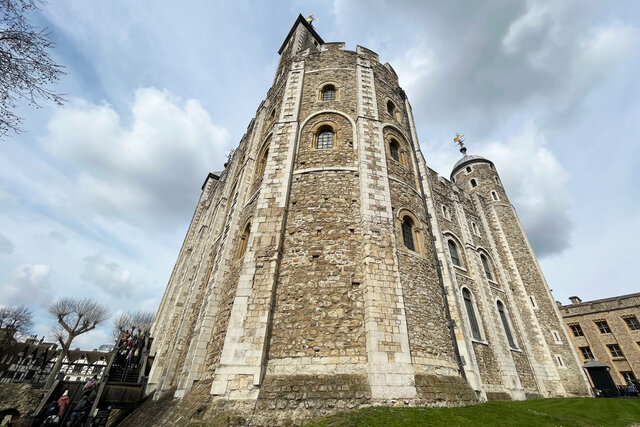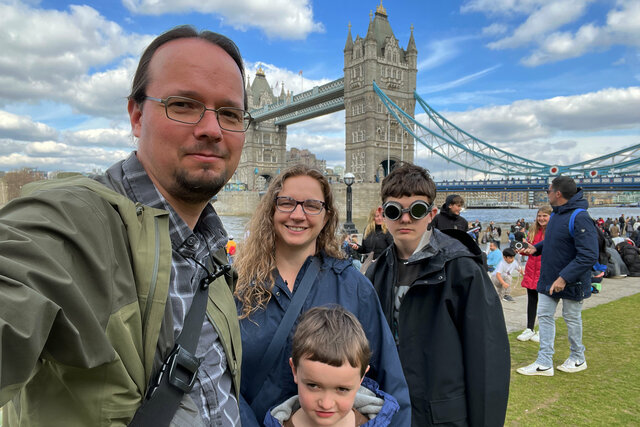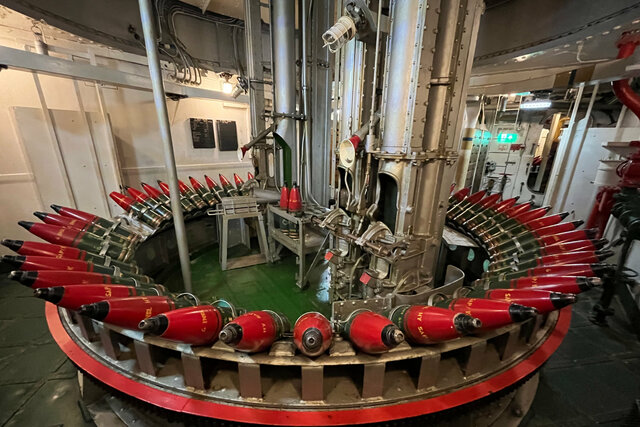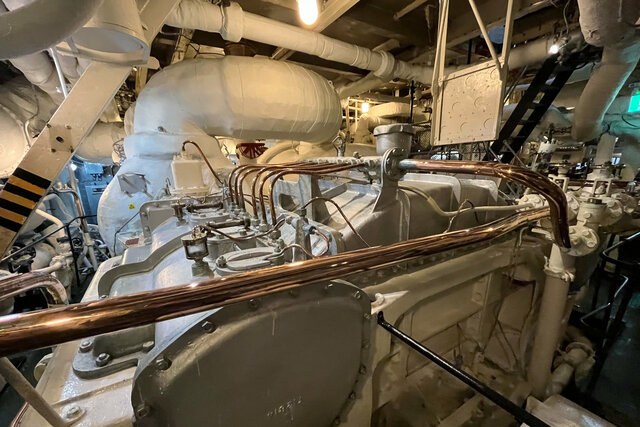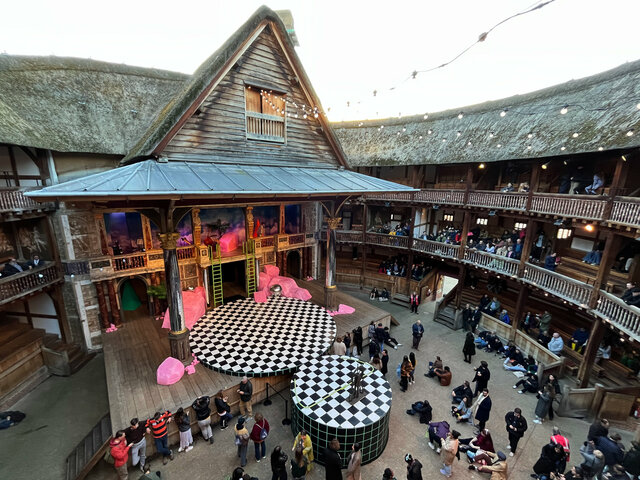Tower of London
Started: 2023-04-22 16:57:09
Submitted: 2023-04-22 23:22:51
Visibility: World-readable
Four distinct eras: The Tower of London, Tower Bridge, HMS Belfast, and a Shakespeare play as he originally intended it
On Saturday, the 8th of April, on our last full day in London, we went to the Tower of London.
We took the sub-surface lines east to Tower Hill, then joined the crowd of tourists departing the station heading towards the tower. Our timed ticket gave an arrival window (09:30 to 09:59), and it looked like there was no provision for walk-up visitors, at least on the bank holiday weekend.
Inside the tower we picked up audio guides, using the prepaid voucher that was inexplicably printed first in the ticket PDF, before the actual entry ticket. We ended up in a narrow passage between two sets of stone walls forming consecutive rings of the defensive fortifications of the tower, and it wasn't immediately obvious from the map or the signs on the ground where we should go to start the tour. The first thing to see seemed to be the Traitor's Gate; then we climbed up the battlements on the outer wall for a tour of the Tudor-era royal apartments built into the wall. Inside the apartments much of the original finishings were partially stripped away (including some much-more-recent wallpaper), revealing the half-timber construction and the plaster finishing the walls.
The tour continued along the battlements, showing off a series of rooms built in various eras, each with their own eclectic history and artifacts. The route between the rooms in the towers took us along the top of the battlements, giving us a view of the White Tower, the oldest building in the tower.
Outside the walls we saw the Shard and the Tower Bridge, two landmarks of modern London built in different eras, each much newer than the Tower itself.
At the entrance to the tower a sign warned us that the audio guide and displays inside the castle had not been updated since the death of Queen Elizabeth II. The yeoman warders ("Beefeaters") wandering around the castle still had the letters "E II R" on their uniforms, referring to the now-deceased queen. It wasn't clear when their uniforms would be updated to refer to the newly-ascended monarch (presumably with the letters "C III R") or whether they were waiting for his official coronation in the next month.
The battlements took us half-way around the tower, from the Traitor's Gate on the south wall, around the east wall, to the north-west corner of the wall, showing a variety of exhibits on the history of the tower in different eras, including an exhibit on the royal menagerie at the tower and (in a different building on the wall) Lord Wellington fortifying the tower against public unrest in the early nineteenth century.
When we climbed down from the battlements we were near the entrance to the building displaying the Crown Jewels; though the queue stretched beyond the snaking barricades set up for that purpose and stretched onto the grounds beyond. The queue kept growing as we watched; it eventually hit the wall on the south side of the courtyard and looped around. I decided I would rather step into the White Tower than wait in the queue. The most important pieces of the crown jewels weren't even on display; they had been removed to prepare for the coronation next month.
The White Tower was built by William the Conqueror after he invaded in 1066 to enforce his new control over the people of London. Over the centuries the tower grew to incorporate multiple outer walls and other buildings in the compound, and the tower itself was used for various purposes, most significantly as the royal armory. In the nineteenth century the Tower was no longer useful as a defensive fortification; the White Tower itself was turned into a museum for curious visitors to pay admission and see the historic armor and weapons.
This included a row of kings, dressed up armor (Elizabeth I was left out of the line of armored kings), including Henry VIII's suit of armor with its ridiculous codpiece, originally mounted astride a horse.
There was so much to see in the White Tower that it was hard to take it all in. There were weapons and armor from centuries of English history, including a display of elaborately-decorated firearms, and in most of the galleries the audio guide punted and just asked us to look around and see whatever we wanted.
The tour took us on a complicated one-way route through the tower, climbing and descending stairs, without a sense of how far we had come and how much was left to see. At one point the curators had apparently given up on the idea of displaying the small arms in the collection individually and had instead combined it in a mismatched dragon towering above the visitors as we entered another floor of the tower.
We left the tower by way of the gift shop, where we indulged Julian's request to buy another souvenir mug, on the theory that one can never have too many mugs. (Julian has gotten into drinking herbal tea; his current favorite is Tazo's wild sweet orange tea, which he makes by himself using the electric teakettle in the kitchen.) We ate lunch at the on-site cafe, then dropped by the ravens on our way out of the tower.
Our next stop was the Tower Bridge, where I had reserved timed tickets at 13:30. We could see the Tower Bridge from the exit from the Tower, but to get to the visitor's entrance on the west side of the north tower we had to follow a somewhat-circuitous route on the footpath under the bridge, then backtracking to reach the correct walkway. Then on the crowded pedestrian walkway leading across the bridge we had to find the right line for timed tickets. (The Tower Bridge had two queues for timed tickets and walk-up visitors, and both were advancing at approximately the same rate.)
I've been to the Tower Bridge a couple of times before (most recently on a special tour into the bascule chamber under the south pier) so this time I wanted specifically to take my kids to this wonder of Victorian engineering, dressed up in neo-Gothic glamor hiding the modern steel truss of the main towers. We climbed the stairs up the west leg of the north tower, stopping to see the exhibit about the cassions used to dig the foundation of the bridge into the mud under the river, then ascended the rest of the way up to the level of the upper walkways. Here we watched a video of the construction of the bridge, then set out onto the walkway.
There were a couple of interpretive displays on the walkway, plus the views out the windows on either side of the walkway of the river and the buildings beyond. I attempted to add context to the displays, talking about the original design intent of the walkways (to provide an uninterrupted pedestrian path, regardless of whether the bridge was up or down) and how the rivets were used to assemble the steel beams on the site to build the truss that still holds the bridge up today.
And then we reached the part of the walkway where the floor was replaced by a window with a clear view of the bridge deck far below, allowing visitors the terrifying thrill of a a death-defying walk across the void, which is apparently perfectly fine for people with different neurochemistry than me. Julian seems to have inherited my height anxiety, so as we approached the crowded gauntlet I guided him to the tiny strip of solid floor on the far side, where we could each grab the shaky railing mounted to the side of the walkway and pick our way along the edge, advising him (and myself) not to look down into the vertiginous drop below us. This worked well enough until we made it two-thirds of the way past the drop, when a woman pushing a pram in front of us stopped on the little walkway until I asked if she could let us pass.
We reached the south tower, where the displays continued on the other walkway on the other side of the tower. This would have involved crossing the identical gauntlet of fear on the other (twice: once going out and once coming back) so Julian and I decided we did not need to see all of the displays on the other walkway. We descended half-way down the tower, to a floor with some additional displays with artifacts from the original construction of the bridge, before heading out into the mid-afternoon sun to follow the blue line on the pavement, down the steps off the side of the bridge, and into the arches under the approach on the opposite side of the bridge where we found the boilers and steam engines that originally powered the bridge, until the bridge was modernized to electrically-powered oil hydraulics in the 1970s.
We stopped by the gift shop on the way out, then staged our family Christmas photo as a selfie in front of the Tower Bridge.
The next thing on my agenda was to visit HMS Befast, a light cruiser that served the Royal Navy during the second world war and is now preserved as a museum ship. (In all of my trips to London, I never managed to visit the ship.) Julian and Kiesa decided they didn't need to visit the ship, so I took Calvin. The museum offered advanced timed tickets, but I didn't want to commit to a time because I wasn't sure when we would arrive. It turned out there was no line; we walked right up and paid on the spot and walked onto the ship. On board the ship was one of the least crowded things we visited all week.
The self-guided tour, augmented by the audio guide, seemed to have an opinion about what order we ought to visit the ship, with some one-way sections intended to reduce congestion climbing up and down the narrow stairs, but the precise path didn't seem to be clearly marked. We walked through the ship's main deck, including the galley and mess hall, with a bakery (where the ship could provide fresh bread to other ships in its battle group, if it were the largest ship in a convoy) and the ship's food storage, with a stuffed cat set up to represent the ship's cat (presumably an able seacat) responsible for protecting the food storage from rodents while underway.
We walked through the sick bay, then followed a steep narrow ladder down into one of the magazines for the ship's primary offensive weapon, the 6" gun turrets above us on the main deck. As the turret rotated the loading elevator rotated in the magazine, and the crew had to lift the shells into the elevator by hand to raise them into the gun turret above. The gunpowder charges used to fire the gun were loaded separately, I think in the same stack but on a lower level, to try to keep the explosive charges even further from possible damage by enemy fire.
On a lower deck in the middle of the ship, in a series of windowless chambers forming the control center of the ship, we saw the Admiralty Fire Control Table, a mechanical computer that combined data about the ship's movement and position relative to the target (and, I think, range data from the targeting radar) to calculate firing solutions for the main guns. Down the corridor was the radio room and the helm, where a crewmember drove the ship, with only a compass and the disembodied voice of the captain on the bridge to guide them. There was an interactive exhibit demonstrating the challenge of driving the ship without being able to see where it was going, which was interesting to watch the other visitors try to navigate a simple maneuver.
The tour route took us back up a series of ladders and down again into the engineering spaces, starting with the boiler room and moving into the adjacent engine room. The ship was powered by burning oil in a furnace to make steam, then pushing the steam through turbines, which was further reduced through gearboxes to power the four propellers. We visited one of the two boiler and engine rooms on the ship; each powered two of the propellers. (I believe we visited the forward engine room, which powered the outer propellers at the ship's stern.)
Throughout the boiler and engine rooms signs warned us of the presence of asbestos in the insulation on the equipment. I appreciated the warning, though in practice asbestos is only dangerous when inhaled, and the only way we could inhale it would be if we were removing the insulation from the equipment without the proper protective equipment.
One of the steam turbines in the engine room was open to show the fine detail of the turbine blades. I'm not sure I've seen a steam turbine open; I was impressed by how tiny each of the blades were, and how many of them there were to derive power from the steam. As the steam loses pressure the turbine grows larger to extract the energy that remains, until finally the steam is condensed to return to the boiler to begin the cycle all over again.
We finished our tour of the engineering spaces and headed up to the upper decks. Here we saw officer's quarters, and outside on the decks we climbed into one of the main turrets to try to get an idea of what it took to fire the 6" main guns. We saw the smaller defensive anti-aircraft turrets, then climbed the superstructure to see the command deck and the flag deck. As a light cruiser, Belfast was equipped with a flag deck allowing the ship to function as a flagship for independent fleet operations, especially convoy escort operations across the North Atlantic.
After two hours on the ship we'd seen what we came to see: climbing down into the magazine and engineering spaces and climbing into the command and flag decks to see the preserved ship, a relic of an earlier era now fading from living memory. It was time to disembark for supper.
We met Kiesa and Julian on the shore and walked to Patty & Bun's London Bridge location. We were seated in the basement, where the table service was provided only through ordering by the QR code taped to the table. We ordered our burgers, and then the serving staff came by with our drinks and told us the kitchen was backed up and we might have to wait half an hour for our food. Our food arrived with enough time for us to eat before our theatre tickets. (The one advantage of the mobile ordering was that we didn't have to wait for our server to appear at the right moment to ask for the check.)
The last thing on our calendar was tickets for a performance of The Tempest at the Globe Theatre on the south bank of the Thames. We had seats on the front row of the upper balcony, with a tiny railing separating my knees from the open space above the stage. I had less leg room than an airplane seat. We rented cushions with our seats, which made the bench seats somewhat less uncomfortable. (I was afraid to get out my phone, since there wasn't much to prevent me from dropping it; before the performance, someone else in a different section of the upper balcony dropped their drink down two stories to the ground below.)
The performance started at 19:00 and included a live band accompanying the actors on stage. I knew enough of the story to get the gist of what was happening on the stage (Kiesa read us two different prose adaptations of the story when the power went out last month), and it seemed like a culturally-significant experience to see a Shakespeare play performed in an open-air, thatched-roof theatre like those in the first Elizabethan Era.
When the play concluded we filed out of the theatre, returned our cushions to the booth in lobby outside, and walked along the south bank of the Thames. Here we saw St. Paul's across the Thames, brightly illuminated at night and surrounded by construction cranes. I stopped to get a picture of the scene. Many people over the centuries have captured this view in their media of choice; this is mine, the neoclassical dome shining in the spotlights and the light reflected off the river.
We crossed the Millennium Bridge, framing the glowing dome of St. Paul's in front of us, and made our way to Blackfriars station to catch the subsurface lines west to the flat in South Kensington one last time before returning home the next morning.
I took even more pictures at the Tower and Tower Bridge at Photos on 2023-04-08.




